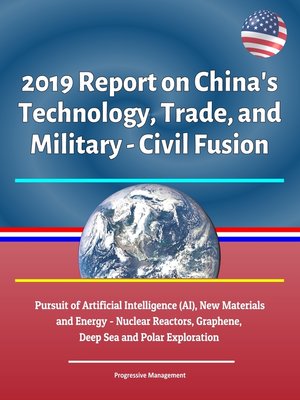2019 Report on China's Technology, Trade, and Military--Civil Fusion
ebook ∣ Pursuit of Artificial Intelligence (AI), New Materials and Energy--Nuclear Reactors, Graphene, Deep Sea and Polar Exploration

Sign up to save your library
With an OverDrive account, you can save your favorite libraries for at-a-glance information about availability. Find out more about OverDrive accounts.
Find this title in Libby, the library reading app by OverDrive.



Search for a digital library with this title
Title found at these libraries:
| Library Name | Distance |
|---|---|
| Loading... |
This important report compilation contains the testimony of eight noted experts on the fusion of Chinese military and civil advanced technology at a hearing on June 7, 2019. Vital emerging Chinese tech frontiers detailed in this report include artificial intelligence (AI), computer systems, the role of data in digital authoritarianism, electronics, aerospace, composite materials, graphene, clean energy, nuclear power, and lithium batteries.
Panel I: U.S.-China Competition in Artificial Intelligence: Policy, Industry, and Strategy - 1. Jeffrey Ding, China lead for the Center for the Governance of AI, Future of Humanity Institute, University of Oxford; D.Phil. Candidate, University of Oxford / 2. Helen Toner, Director of Strategy at Georgetown University's Center for Security and Emerging Technology / 3. Elsa Kania, Adjunct Senior Fellow, Technology and National Security Program at the Center for a New American Security; Research Fellow at CSET
Panel II: Maintaining Commercial and Technical Leadership in New Materials / 4. Dan Coughlin, Vice President of Composites Market Development, American Composites Manufacturers Association / 5. Alan Hill, Government Relations Partner, National Graphene Association; President, J. A. Hill Group, LLC
Panel III: China's Capabilities and Export Ambitions in New Energy, Nuclear Power, and Energy Storage - 6. Joanna Lewis, Ph.D., Associate Professor of Science, Technology and International Affairs, Georgetown University / 7. Jessica Lovering, Director of Energy at the Breakthrough Institute, Ph.D. Student at Carnegie Mellon University / 8. James Greenberger, Co-founder and Executive Director of NAATBatt International
Excerpts: If China's first major clean energy technology successes were in wind and solar, their next big success is poised to be in energy storage. Energy storage technologies represent a $620 billion investment opportunity over the next two decades. While China is still in the early stages of energy storage deployment and utilization, its companies are already among the world's top energy storage technology manufacturers. At the end of 2017, the Chinese government released a 10-year plan for developing a domestic energy storage industry for two key purposes: (1) to support battery manufacturing for its already massive electric vehicle manufacturing enterprise; and 2) to help with the serious grid challenges related to integrating substantial amounts of wind and solar power into the grid... The PLA is avidly pursuing and prioritizing military innovation. Chinese leaders assess that a new Revolution in Military Affairs is underway that presents urgent challenges and historic opportunities for China. In August 2014, the Politburo devoted a study session to the topic of new trends in global military developments and promoting military innovation. At the time, Xi Jinping discussed the emergence of this "new RMA," calling for China to keep pace with the times in "vigorously advancing military innovation" in order to "narrow the gap and achieve a new leapfrogging as quickly as possible." Xi Jinping's exhortation continues a legacy and trajectory of military modernization that can be traced to the initial reaction of Chinese leaders, including Jiang Zemin himself, to the Gulf War and early American thinking on the RMA. In his remarks at the time, Xi called upon the PLA to carry forward its tradition of innovation through striving to develop new military theories, institutional structures, equipment systems, strategy and tactics, and models for management that could fulfill the demands of its missions in an era of informatized warfare. For China, the emphasis on leveraging science and technology to...







